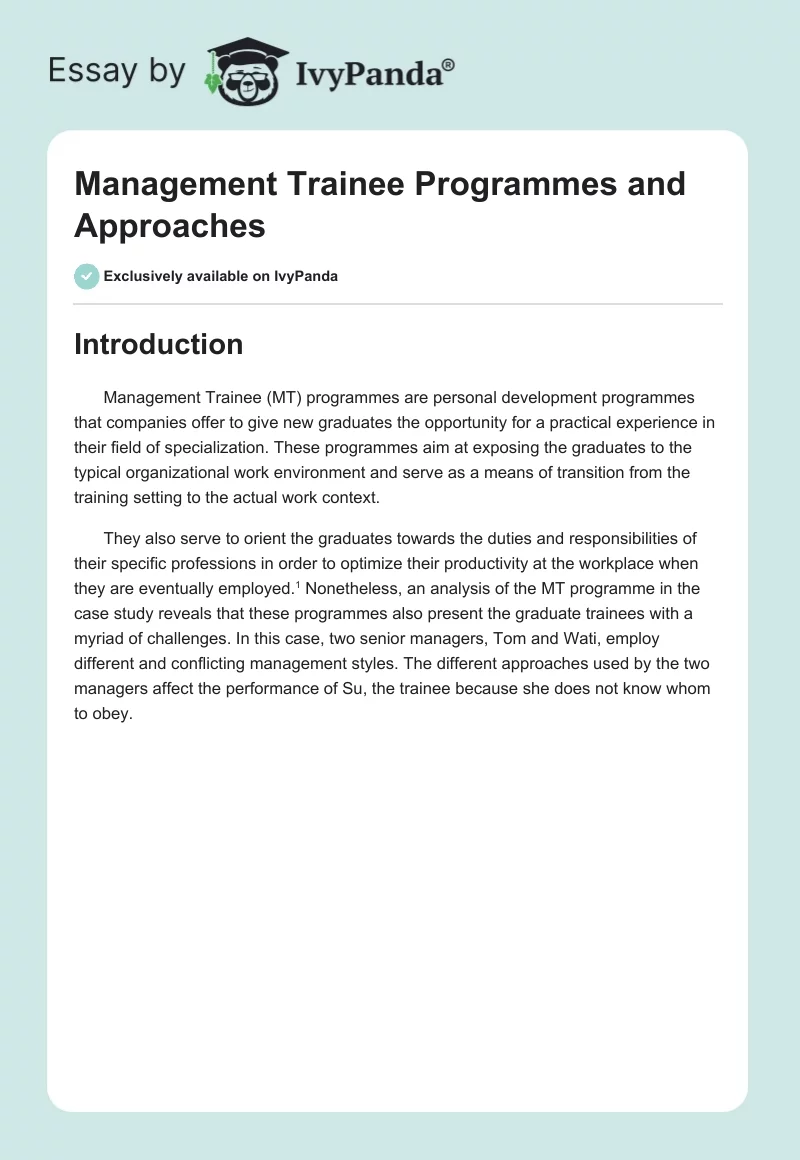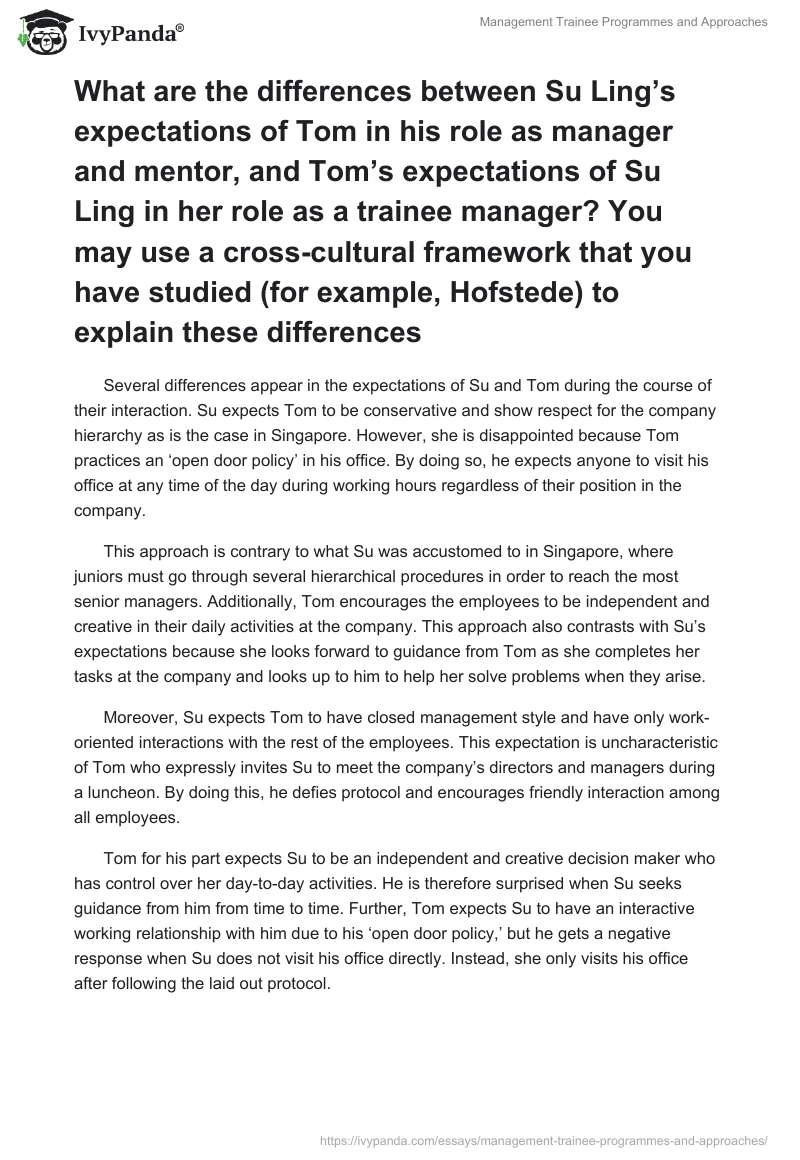Introduction
Management Trainee (MT) programmes are personal development programmes that companies offer to give new graduates the opportunity for a practical experience in their field of specialization. These programs aim at exposing the graduates to the typical organizational work environment and serve as a means of transition from the training setting to the actual work context.
They also serve to orient the graduates towards the duties and responsibilities of their specific professions in order to optimize their productivity at the workplace when they are eventually employed. Nonetheless, an analysis of the MT programme in the case study reveals that these programmes also present the graduate trainees with a myriad of challenges. In this case, two senior managers, Tom and Wati, employ different and conflicting management styles. The different approaches used by the two managers affect the performance of Su, the trainee because she does not know whom to obey.
What are the differences between Su Ling’s expectations of Tom in his role as manager and mentor, and Tom’s expectations of Su Ling in her role as a trainee manager? You may use a cross-cultural framework that you have studied (for example, Hofstede) to explain these differences
Several differences appear in the expectations of Su and Tom during the course of their interaction. Su expects Tom to be conservative and show respect for the company hierarchy as is the case in Singapore. However, she is disappointed because Tom practices an ‘open door policy’ in his office. By doing so, he expects anyone to visit his office at any time of the day during working hours regardless of their position in the company.
This approach is contrary to what Su was accustomed to in Singapore, where juniors must go through several hierarchical procedures in order to reach the most senior managers. Additionally, Tom encourages the employees to be independent and creative in their daily activities at the company. This approach also contrasts with Su’s expectations because she looks forward to guidance from Tom as she completes her tasks at the company and looks up to him to help her solve problems when they arise.
Moreover, Su expects Tom to have closed management style and have only work-oriented interactions with the rest of the employees. This expectation is uncharacteristic of Tom who expressly invites Su to meet the company’s directors and managers during a luncheon. By doing this, he defies protocol and encourages friendly interaction among all employees.
Tom for his part expects Su to be an independent and creative decision maker who has control over her day-to-day activities. He is therefore surprised when Su seeks guidance from him from time to time. Further, Tom expects Su to have an interactive working relationship with him due to his ‘open door policy,’ but he gets a negative response when Su does not visit his office directly. Instead, she only visits his office after following the laid-out protocol.
What are the differences between the management styles of Tom and Wati? How can Tom manage these differences to minimise conflict and maximise benefit to the organisation? What can Tom and Wati learn from each other?
Tom’s management style is liberal, open, independent, creative, and pragmatic. These attributes manifest on several occasions. He encourages junior employees to bypass protocol, while visiting his office. He also engages employees directly in their work areas and inquires about their personal welfare. He challenges Su to be creative and come up with mechanisms by which she can improve sales at ‘The Veranda’ without offering her any guidelines to that effect despite her request for guidelines. Additionally, he asks Su to draw a new floor plan that could lead to a boost in sales, for the women’s wear department without necessarily adhering the company’s requirements. These tasks are his way of assessing the practicability of Su’s ideas as well as her creativity.
Wati is, on the other hand, conservative and procedural in his approach. These attributes manifest on several occasions in his interaction with employees. He upholds the company’s guidelines and gets offended when Tom and Su bypass protocol and interact without passing through his office. He also maintains limited interaction with junior employees in order to maintain the status quo within the company. In addition, Wati uses an authoritative management style. He questions Su’s new floor plan due to its failure to conform to the guidelines and requirements of the company.
In an effort to minimize conflicts, Tom should encourage Wati to be accommodative towards new ideas and independent. Tom should also encourage Wati to develop a global view of issues. This transformation can be achieved by transferring Wati to other branches of the company around the world. Wati can also learn from Tom the benefits of being liberal, creative, independent, and accommodating towards new ideas because Tom’s leadership style has been tested and proven to yield good results. Wati also has something to offer because Tom can learn from him how to maintain a social environment that fosters respect between juniors and seniors.
The MT program was highly successful in the UK. Su Ling’s experience suggests that it may not always be as effective in other countries (for example, Singapore). Why is this so? How can it be improved to ensure greater success with future groups of trainee managers?
MT is not as successful in other countries as it is in the UK. The reasons behind this disparity are the social and cultural differences that exist in various countries. Various cultural differences affect the performance of employees and need to be considered before any MT programme is initiated. There is also the aspect of cohesion within companies. Companies must ensure that cohesion exists among their employees and that there is cordiality among all of them. This kind of relationship encourages the sharing of ideas among employees thereby leading to the development of the concerned company.
The management style employed by senior managers also has a bearing on the success of MT programmes since it determines the level of interaction between the juniors and seniors in a company. The management style can also foster or curtail the freedom of introducing new ideas in a company. In order to ensure success for future trainees, there should be an overhaul of the company’s structural framework and guidelines to achieve a uniform standard among all its branches. This overhaul will provide a levelled playground for the application of the company’s rules and regulations across all its branches.
What advice would you give to Su Ling, given the dilemma that she is faced with? Should she attend the meeting or should she avoid attending it? Should she resign? What are her options and what course of action would you recommend?
I would advise Su Ling to confide in Tom privately and explain to him about the organizational culture in Singapore. It would also be important for her to conceal her innovative ideas from Wati until the company employs her. After that, she can be free to open up and share her ideas. I would also advise her to attend the meeting since her presence at the meeting could lead to the tackling of the issues that affect MT programmes and would in turn be beneficial to future trainees. She would have an opportunity to open up to the managers about the difficulties that trainees face. Such an opportunity would also demonstrate her courage and initiative to the management.
If she stands for the truth, she will project herself as a person who can remain truthful, even if it translates to losing her job. Speaking out her mind could also lead to a change of the company’s guidelines and give it an edge for improving sales. Su should not resign since that would mean that she is a coward and unworthy of being elevated to any senior position in the company. Her options are to submit truthful feedback about the performance of her supervisors and mentors. She can also open up to Tom about her fears so he can help her to devise a way of averting her unfair dismissal. Lastly, I would advise her to be true to herself and avoid the pitfall of conforming to the cultural ways of Singapore. By being herself, she will be able to develop new ideas that will be beneficial to a great number of people.
Reference List
Downs, Lisa, Time Management Training (Alexandria, VA: American Society for Training and Development, 2008).
Evenson, Renee, Customer Service Management Training 101: Quick and Easy Techniques That Get Great Results (New York, NY: AMACOM, 2011).
Gulbenkoglu, Hrepsime, and Hagiliassis, Nick, Anger Management: An Anger Management Training Package for Individuals with Disabilities (London: Jessica Kingsley Publishers, 2006).
Shackelford, Blain, Project Management Training (Alexandria, VA: American Society for Training and Development, 2004).


